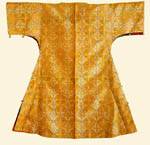|
|
| Church Embroidery |
16th c., 1st half Dionysiou Monastery 127 x 128 cm |
|

|
This sakkos (dalmatic) is sewn in the traditional Byzantine manner, with wide sleeves formed from two straight pieces of cloth stitched to the body of the robe at the shoulders and fastened with round buttons down the sides (Johnstone 1967, figs. 1, 7, 11). The material is a luxurious double damask woven in gold and silver thread in a pattern of medallions framing busts of Christ as the Great High Priest, alternating on the horizontal rows with seraphs in smaller circlets. The intermediary spaces are ornamented with crosses fleury. Christ is depicted wearing a sakkos decorated with crosses in medallions and an omophorion with large crosses, over a long-sleeved inner garment. He has a cruciate halo around which is woven (in reverse) the inscription: 'Jesus Christ, the Great High Priest'. The monograms around the cross, Jesus Christ Conquers, are also woven back to front. The sakkos is made from one of a small number of fabrics decorated with Christian iconography produced, doubtless to order, by weavers in Bursa or Constantinople (cf. Pyles Mysteriou 1994, no. 129). These looms executed the usually pressing commissions from the Sublime Porte, but their textiles were also sold on the open market and exported to southern Russia, Poland and Venice (Inalcik EI². See also Patrinelis 1988-9, Sahillioglu 1985). At least three other known textiles have variations on this theme of Christ the Great High Priest within medallions, but with the inscriptions woven correctly: these are in the Benaki Museum (inv. no. 3871) in Athens, the Solka Monastery and the Putna Monastery in Romania (Barnea - Iliescu - Nicolescu 1971, no. 90, p. 128. Tafrali 1925, no. 116, pl. LIX). The last noted has the embroidered date 1614: this is a terminus ante quem, being the date when it was sewn to other pieces of cloth to make a phelonion. On the basis of the evolution of Ottoman decorative motifs, most Ottoman fabrics are dated to the mid-sixteenth century or later (Mackie 1980, p. 352). The absence from this sakkos of any typically Ottoman ornamentation suggests a date in the first half of the sixteenth century. A document date 1548 attests that Ottoman merchants in Leontopolis (Lwow) were selling textiles 'with crosses' (Rogers - Tazcan - Delibas 1986, p. 29), which means that these had already been available on the domestic market for some time. An early dating is supported by the pattern of repeated medallions, already considered archaic in the fifteenth century (Geijer 1979, pp. 143, 146-8). This archaism may be interpreted either as an adherence to painted prototypes of this iconographic theme (Papamastorakis 1993-4) or as the survival of Late Byzantine models in a period not very far removed from the Fall of Constantinople. Tradition assigns this vestment to St Nephon, an Athonite monk who served as Patriarch three times (1486-9, 1497-8, 1502). After a brief sojourn in Wallachia, he returned to his own Monastery of Dionysiou where he remained until his death in 1508 (Actes de Dionysiou 1968, p. 18. Nasturel 1986, p. 142-4). There is nothing in the style or technique to refute this tradition, which would make the Dionysiou sakkos the oldest dated textile from the Bursa looms, and certainly the oldest in the series with Christian inscriptions.
| |
|
Bibliography: Unpublished.
| ||
| A. B. | ||
| Index of exhibits of Monastery of Dionysiou 16th century |
||
Reference address : https://www.elpenor.org/athos/en/e218ck1.asp